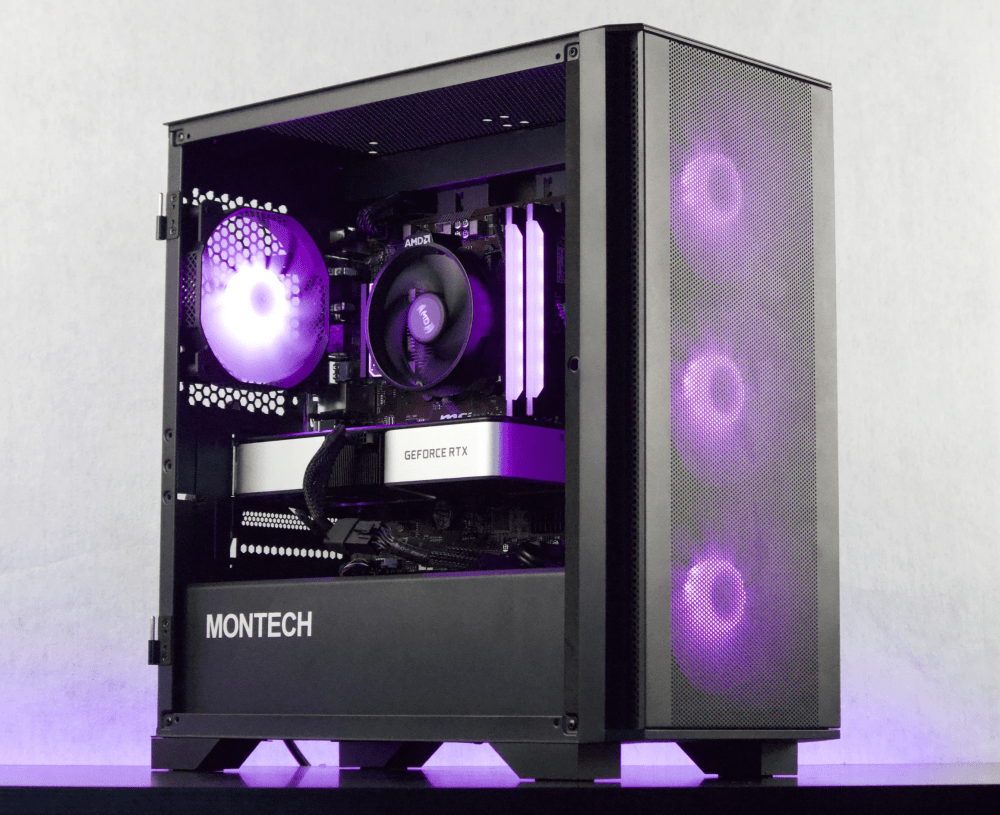Are you a music producer looking to take your music production to the next level? One key ingredient in achieving professional-quality sound is having a dedicated PC for music production. Building your own PC specifically designed for music production can provide you with the performance and capabilities you need to create, mix, and master your tracks with precision and efficiency.
In this blog post, we will guide you through the process of building a PC that is optimized for music production. We will cover everything from choosing the right components to assembling the PC step-by-step. Additionally, we will discuss setting up the necessary software for music production and provide tips on how to maintain and upgrade your custom-built music production PC.
By the end of this blog post, you will have a comprehensive understanding of what it takes to build a PC that meets the demands of music production. So, let's dive in and get started on your journey to creating the perfect music production setup!
Introduction: Understanding the Importance of a Dedicated PC for Music Production
When it comes to music production, having a dedicated PC specifically designed for this purpose is of utmost importance. While it may be tempting to use a regular computer for your music production needs, a dedicated PC offers several advantages that can significantly enhance your workflow and the quality of your final product.
One of the primary reasons for using a dedicated PC for music production is the increased processing power it provides. Music production involves complex tasks such as recording, editing, mixing, and mastering multiple tracks simultaneously. These processes require a substantial amount of computational power to handle the high demands of digital audio processing. A dedicated PC with a powerful processor can handle these tasks more efficiently, allowing you to work seamlessly without any lag or performance issues.
Another crucial aspect of a music production PC is the amount of RAM (Random Access Memory) it has. RAM plays a vital role in handling large audio files, virtual instruments, and plugins. With more RAM, you can load and manipulate multiple audio tracks and virtual instruments simultaneously, without experiencing any slowdowns or crashes. This is particularly beneficial for those working on complex compositions or orchestrations.
Choosing the right hard drive for your music production PC is equally important. Traditional hard drives (HDDs) are more affordable but tend to have slower read and write speeds. On the other hand, solid-state drives (SSDs) offer faster performance, allowing for quicker loading times of software and audio files. SSDs are particularly beneficial when working with large sample libraries or using virtual instruments that require rapid access to data.
Sound cards, also known as audio interfaces, are crucial components for music production PCs. They provide high-quality audio inputs and outputs, allowing you to connect professional-grade microphones, instruments, and studio monitors. A dedicated sound card ensures accurate and pristine audio recording and playback, eliminating any unwanted noise or distortion.
While graphics cards are not directly related to music production, they play a role in providing a smooth and visually appealing user interface for your music production software. A good graphics card can enhance the visual experience, making it easier to navigate and work with your software efficiently.
In the next sections, we will delve deeper into each of these components, providing you with the knowledge and guidance necessary to choose the right components for your music production PC. So, let's get started on building a powerful and efficient machine that will elevate your music production capabilities!
Choosing the Right Components for a Music Production PC
When it comes to building a music production PC, choosing the right components is crucial to ensure optimal performance and functionality. In this section, we will explore the key components you need to consider when building a PC for music production.
Importance of Processor for Music Production
The processor, or CPU (Central Processing Unit), is the brain of your computer and plays a critical role in music production. It determines how quickly your PC can handle tasks and processes. For music production, you'll want a processor with a high clock speed and multiple cores. This will enable you to handle complex audio processing tasks smoothly and efficiently. Popular choices for music production CPUs include Intel Core i7 or i9 processors and AMD Ryzen processors.
Deciding the Appropriate Amount of RAM
RAM, or Random Access Memory, is responsible for temporarily storing data that your computer needs to access quickly. When it comes to music production, having sufficient RAM is essential for working with large audio files, virtual instruments, and plugins. Aim for a minimum of 16GB of RAM, but consider 32GB or even 64GB if your budget allows. The more RAM you have, the more smoothly you'll be able to work with multiple tracks and resource-intensive plugins.
Choosing the Right Hard Drive
The choice of hard drive can significantly impact the speed and performance of your music production PC. Traditional Hard Disk Drives (HDDs) are affordable and offer ample storage capacity. However, they tend to be slower in terms of read and write speeds. For better performance, consider investing in a Solid-State Drive (SSD). SSDs are faster, more reliable, and can significantly reduce loading times for software and audio files. It's recommended to have a combination of both, with an SSD for your operating system, software, and frequently used files, and an HDD for storage of larger files and sample libraries.
The Role of Sound Cards in Music Production
Sound cards, or audio interfaces, are crucial for capturing and reproducing high-quality audio in music production. They provide inputs and outputs for connecting microphones, instruments, and studio monitors. When selecting a sound card, look for one that offers low-latency recording and playback, high-quality analog-to-digital and digital-to-analog conversion, and sufficient inputs and outputs to meet your specific needs. Popular choices include Focusrite Scarlett, PreSonus AudioBox, and Universal Audio Apollo interfaces.
Understanding the Need for a Good Graphics Card
While not directly related to music production, a good graphics card can enhance your overall experience when working with music production software. It provides smoother graphics rendering, allowing for a more fluid and visually pleasing user interface. This can be helpful when navigating complex projects or working with visually intensive plugins. Look for a graphics card with a decent amount of VRAM (Video RAM) and consider models from NVIDIA or AMD that offer good performance and compatibility with your software.
In the next section, we will guide you through the step-by-step process of assembling your music production PC, ensuring that all the chosen components are properly installed and connected. So, let's move on to the exciting part of bringing your PC to life!
Assembling the PC: Step-by-Step Guide
Now that you have chosen the right components for your music production PC, it's time to assemble them and bring your custom-built machine to life. In this section, we will provide you with a step-by-step guide on how to assemble your PC for music production.
Preparing the Workspace
Before you begin assembling your PC, it's important to create a clean and static-free workspace. Clear a large, flat surface and gather the necessary tools, such as a screwdriver, cable ties, and thermal paste. Ensure that you have ample lighting and enough space to work comfortably.
Preparing the Motherboard
Start by placing your motherboard on the workspace. Carefully align the screw holes on the motherboard with the standoffs in the PC case. Once aligned, secure the motherboard to the case using screws. Be cautious not to overtighten the screws, as it may damage the motherboard.
Installing the Processor
Next, it's time to install the processor into the motherboard. Open the CPU socket on the motherboard and gently place the processor into the socket, aligning the notches or markers on the processor with those on the socket. Once properly aligned, close the socket cover, securing the processor in place. Apply a small amount of thermal paste onto the processor before attaching the CPU cooler.
Installing the RAM
Insert the RAM sticks into the appropriate slots on the motherboard. Ensure that you align the notch on the RAM stick with the slot on the motherboard. Apply even pressure on both ends of the RAM stick until it clicks into place. Verify that the RAM is securely installed by gently pushing down on it.
Installing the Hard Drive and Graphics Card
Mount your hard drive(s) into the appropriate drive bays in the PC case. Use screws or brackets provided with the case to secure the hard drive in place. Connect the necessary cables, including the SATA data cable and SATA power cable, to the hard drive.
To install the graphics card, locate the PCIe slot on the motherboard and remove the corresponding metal bracket on the rear of the case. Carefully align the graphics card with the PCIe slot and firmly press it down until it is fully seated. Secure the graphics card by screwing it into the case using the provided screws.
Setting up the Cooling System
Depending on the type of CPU cooler you have, follow the manufacturer's instructions to install it onto the processor. Ensure that the cooler is firmly attached and connected to the appropriate power source, whether it's a fan header on the motherboard or a separate power connector.
Connecting the Power Supply
Mount the power supply unit (PSU) into the designated area in the case and secure it with screws. Connect the necessary cables from the PSU to the motherboard, graphics card, hard drive, and any other components requiring power. Ensure that all connections are secure and properly seated.
Congratulations! You have successfully assembled your music production PC. In the next section, we will guide you through the process of setting up the necessary software for your music production needs. Let's move on to the next step to get your PC ready for music creation!
Setting Up the Software for Music Production
Now that you have assembled your music production PC, it's time to set up the necessary software to unleash its full potential. In this section, we will guide you through the process of setting up the software for music production.
Installing Audio Production Software
Once you have your operating system installed, it's time to install your preferred Digital Audio Workstation (DAW) and other essential music production software. There are several options available, including industry-standard software like Ableton Live, Logic Pro X, Pro Tools, FL Studio, and Cubase. Choose the software that aligns with your workflow and offers the features and tools you need for your music production projects.
Follow the installation instructions provided by the software manufacturer, ensuring that you have the latest version of the software. Additionally, consider installing plugins, virtual instruments, and effects that will enhance your creative possibilities and allow you to achieve the desired sound.
Setting Up the Audio Interface
To ensure high-quality audio recording and playback, you need to set up your audio interface correctly. Connect your audio interface to your PC using the provided cables. Make sure to use high-quality cables and connect the inputs and outputs accordingly.
Once connected, install the necessary drivers for your audio interface. These drivers are typically provided by the manufacturer and ensure proper communication between your PC and the audio interface. Follow the manufacturer's instructions to install the drivers and configure the audio settings within your operating system and DAW.
It's crucial to configure the sample rate, buffer size, and audio driver settings to achieve low-latency performance and optimal audio quality. Consult the user manual or online resources specific to your audio interface and DAW for detailed instructions on configuring audio settings.
Setting Up MIDI Controllers and External Gear
If you have MIDI controllers or external gear, such as synthesizers or drum machines, you'll need to set them up to integrate them into your music production workflow. Connect your MIDI controllers using USB or MIDI cables, depending on the connection options available. Install any necessary drivers and configure the MIDI settings within your DAW to enable communication between your MIDI controllers and the software.
For external gear, connect the audio outputs of your gear to the appropriate inputs on your audio interface. Consult the user manuals of your external gear and your audio interface for specific connection instructions.
With your software, audio interface, MIDI controllers, and external gear properly set up, you are ready to dive into the world of music production on your custom-built PC!
In the next section, we will discuss the importance of maintaining and upgrading your music production PC to ensure it continues to meet your needs. Let's explore how to keep your PC in optimal condition for long-term use.
Maintaining and Upgrading Your Music Production PC
To ensure your music production PC continues to perform at its best, regular maintenance and occasional upgrades are essential. In this section, we will explore the importance of maintaining your PC and provide guidance on when and how to upgrade its components.
Regularly Updating Software
Keeping your software up to date is crucial for optimal performance and security. Regularly check for updates for your operating system, DAW, plugins, and drivers. Manufacturers often release updates that address bugs, improve performance, and introduce new features. Set up automatic updates whenever possible to ensure you're always running the latest versions.
Cleaning and Maintaining Hardware
Regularly cleaning and maintaining your hardware can prolong the lifespan of your music production PC. Dust accumulation can lead to overheating and performance issues. Use compressed air or a soft brush to remove dust from the fan blades, vents, and other components. Be cautious when cleaning delicate parts and avoid static discharge by grounding yourself before touching any internal components.
It's also important to monitor the temperatures of your CPU and GPU. Install monitoring software to keep an eye on temperature levels and address any overheating issues promptly. Consider investing in additional cooling solutions, such as aftermarket CPU coolers or case fans, if your PC is consistently running hot.
When and How to Upgrade Components
Over time, you may find the need to upgrade certain components of your music production PC to keep up with evolving software requirements or to enhance performance. Here are some components you might consider upgrading:
- Processor (CPU): Upgrading your CPU can provide a significant boost in processing power, allowing for faster audio rendering and handling more demanding software.
- RAM: If you find yourself running out of memory or experiencing slow performance when working with large projects or resource-intensive plugins, upgrading your RAM can help.
- Storage: Upgrading to a faster SSD or adding additional storage can improve load times, increase project handling capacity, and accommodate larger sample libraries.
- Graphics Card (GPU): While not directly related to music production, upgrading your GPU can enhance the visual experience and improve performance in graphics-intensive plugins or visualizers.
Before upgrading any component, consider compatibility with your existing hardware and software. Research the specifications and requirements of the components you plan to upgrade, and ensure they are compatible with your motherboard, power supply, and other components.
Back up your important files and data before performing any upgrades, and follow the manufacturer's instructions for installation carefully. If you're uncertain or uncomfortable with upgrading components yourself, seek assistance from a professional technician.
By regularly maintaining and selectively upgrading your music production PC, you can ensure it remains a reliable and high-performing tool for your creative endeavors.
In the concluding section, we will summarize the key points discussed throughout this blog post and encourage you to enjoy the benefits of your custom-built music production PC. Let's wrap things up and get ready to create some amazing music!
Conclusion: Enjoying Your Custom-Built Music Production PC
Congratulations on building your own custom music production PC! By carefully choosing the right components, assembling them with precision, setting up the necessary software, and maintaining your PC, you have created a powerful tool that will elevate your music production capabilities.
A dedicated PC for music production offers numerous advantages, including increased processing power, ample RAM for handling large projects, fast storage for quick access to audio files, high-quality audio interfaces for pristine recording and playback, and a smooth user experience with a good graphics card.
Remember to keep your PC in optimal condition by regularly updating software, cleaning hardware to prevent dust buildup, and monitoring temperatures. Additionally, consider upgrading components when necessary to meet evolving software requirements or enhance performance.
With your music production PC ready, it's time to unleash your creativity and enjoy the benefits of your custom-built machine. Explore the vast possibilities offered by your chosen digital audio workstation (DAW), experiment with plugins and virtual instruments, and bring your musical ideas to life.
Take advantage of the power and flexibility of your music production PC to create, mix, and master your tracks with precision and efficiency. Let your creativity flow and embrace the freedom to produce music that reflects your unique style and artistic vision.
Remember to stay informed about the latest advancements in music production technology, software updates, and new plugins or instruments that can further enhance your music production workflow.
Now, armed with your custom-built music production PC, go forth and create music that resonates with your listeners. Enjoy the journey, embrace the process, and let your passion for music shine through with the help of your powerful and reliable music production PC.
Happy music making!
Want to get a great PC at a killer price? Check out gaming PCs at Jawa, the marketplace for gamers





